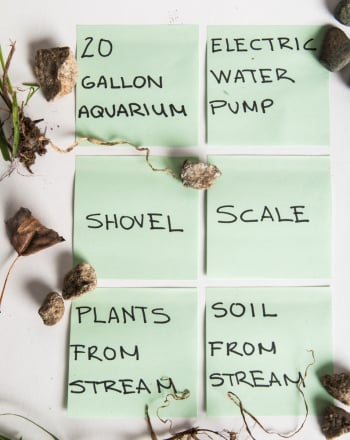Science project
Reynolds Number: Laminar and Turbulent Flow
If you swirl water around in a cup, you’ll notice how easily and fast the water will move. But have you ever tried to swirl some maple syrup around in a cup? It doesn’t respond to your movements in the same way. Liquids have various properties that determine how they flow. One figure that’s used to characterize a fluid’s behavior is called the Reynolds Number.
Problem
Explore the concept of the Reynolds Number.
Materials
- Shallow dish
- Egg beater
- Flat plastic scraper
- Water
- Maple syrup
- Refrigerator
- Straw
- Soap
Procedure
- The day before you perform your experiment, put your maple syrup in the refrigerator.
- Prepare all your items, and pour the cold maple syrup into one of the shallow dishes. Put water in the other dish.
- Blow small bubbles in the two dishes with your straw (you may want to add a little soap to the water to keep the bubbles).
- Place your egg beater in the dish of water, and spin it very slowly. Watch what the bubbles do. Is there a difference between how the bubbles behave when they’re closer to the egg beater?
- Spin the egg beater in reverse in the water. What do you observe?
- Try spinning the egg beater faster in the water. Is anything different?
- Now place your egg beater in the dish of syrup and spin it slowly. Does the syrup behave differently than the water?
- Spin the egg beater in reverse and carefully watch the bubbles.
- Carefully increase the speed of the egg beater in the syrup. Does it react the same way as the water reacted?
- Now take your plastic scraper and perform the same experiments, but instead of using the egg beater, mix the syrup and water with the scraper in fin-like movements. Blow more bubbles if they start to pop. Notice how the syrup sticks to the egg beater when you take it out. How does the plastic scraper affect the water and the syrup differently?
Results
The egg beater will interact with the water and the syrup very differently. In the water the behavior of the bubbles depends on how fast the beater is moving and how far away the bubbles are from the beater. In the syrup these effects are minimal, and often the bubbles will have a constant flow no matter where they are in the bowl. Did you notice that the bubbles move in reverse when you reverse the beater in the syrup, but not in the water? When you move the beater faster in the syrup you can actually see the syrup create depressions and hills on its surface. The water just makes ripples.
The scraper will affect the bubbles in the water, but it will have little effect on the syrup bubbles. The syrup bubbles just move right back to where they were.
Why?
The bubbles are showing you fluid flow, or the direction that syrup and water are moving in the fluid. They behave differently because of their viscosity, which you can think of as their molecular stickiness. When you move the egg beater in the syrup, the syrup next to the mixer moves, but also drags some other syrup along with it because the syrup is sticking to itself. The water isn’t as viscous, so only some of it is dragged along with the mixer’s movements. Also, since the water isn’t viscous, there isn’t as much of a pull slowing it down. When you increase the mixing speed and then turn off the egg beater, the bubbles might continue to spin for a moment before they slow down. The syrup will stop moving as soon as you turn off the beater. In this case, the fluid momentum is greater in water than in syrup.
This brings us to the concept of the Reynolds Number. The Reynolds Number is a ratio of how important inertia (an object or substance’s resistance to change in motion) is versus how important viscosity is in a fluid. You can calculate this figure by dividing inertial forces by viscous forces. When this figure is small (less than 103), viscous forces dominate the system. This situation creates laminar flow, where the fluid flows with no disruption in even, parallel layers (as with the syrup). When this figure is greater than 104, inertial forces dominate the system. This situation creates turbulent flow, where chaotic, circular eddies form that are difficult to measure or predict.

Education.com provides the Science Fair Project Ideas for informational purposes only. Education.com does not make any guarantee or representation regarding the Science Fair Project Ideas and is not responsible or liable for any loss or damage, directly or indirectly, caused by your use of such information. By accessing the Science Fair Project Ideas, you waive and renounce any claims against Education.com that arise thereof. In addition, your access to Education.com's website and Science Fair Project Ideas is covered by Education.com's Privacy Policy and site Terms of Use, which include limitations on Education.com's liability.
Warning is hereby given that not all Project Ideas are appropriate for all individuals or in all circumstances. Implementation of any Science Project Idea should be undertaken only in appropriate settings and with appropriate parental or other supervision. Reading and following the safety precautions of all materials used in a project is the sole responsibility of each individual. For further information, consult your state's handbook of Science Safety.













